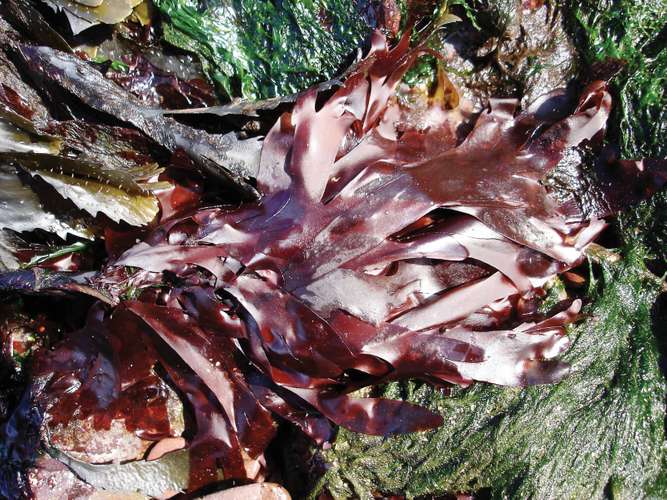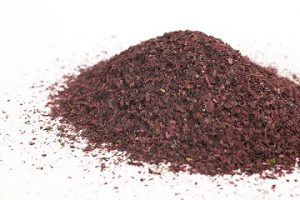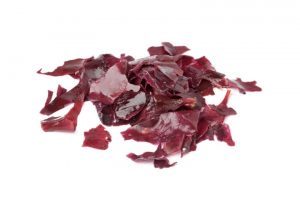
Dulse is full of Iron and Vitamin B12
Foragers tend to ignore seaweed. Granted you need to be near the shore but they are often low on the list when they can be so nutritious. They apparently aren’t alone: In Native American Food Plants by Daniel Moerman he lists only one group, “Alaska Native” as consuming Dulse. Eating it on the northeast coast seems to have been mostly by immigrants from the British Isles who traditionally ate it back home.

Dulse powders and stores well.
I grew up four miles from the sea and saw Dulse often. Indeed, my mother as a kid rowed around most of the islands off southern Maine from Brunswick to Portland as did I as a teenager. I used to go sea bass fishing with an old story-teller named Hap Davis. He couldn’t swim and I often wondered what we would do if we ever sunk. The water’s perpetually cold and the islands always too far away.
Moerman writes Dulse “…leaves air dried and stored for winter use… added to soups and fish head stews… eaten fresh or singed on a hot stove or griddle.” If I remember correctly one saying of northwest natives was: “When the tide is out the table is set. “ And when these shore-dweller ate Dulse what did they get? A huge serving of potassium, some 7,000 mg per 100 grams dried. Said another way dry Dulse is 7% potassium.

Immigrants were fond of Dulse as they ate it in the British Isles.
Nutty-flavored here’s the rest of the nutritional line-up dried: Calories 323, protein 19.1 grams, carbohydrates 59.5 grams, fat 0.6 mg, vitamin C 4.8 mg, and vitamin A 2 IUs, Chlorine 7500 mg, sodium 1740 mg, magnesium 450 mg, calcium 375 mg, phosphorus 360 mg, zinc 71.1 mg (quite high as is) iron 11 mg, manganese 4.5 mg, and copper 4 mg. The B vitamins are B1 (thiamin) 0.23 mg, B2 (riboflavin) 0.76 mg, and B3 (niacin) 5.4 mg. Fresh there are some variations: Protein 1.8 grams, carbohydrates 6.1 grams, vitamin C 38 mg, and vitamin A 285 IUs. Chlorine 1306 mg, magnesium 60.1 mg, calcium 48 mg, zinc 0.8 mg, manganese 0.6 mg, copper 0.2 mg, and molybdenum less than 0.1 mg. The B vitamins are B1 (thiamin) 0.63 mg, B2 (riboflavin) 0.51 mg, and B3 (niacin) 0.2 mg. While there are more minerals dry there is far more vitamin C fresh. Some nutritionists, which we got along without for a very long time, say Dulse has the most iron of all food.
A USDA page for Dulse nutritions says 100 grams (we’ll presume dried) has 22500 mcg of iodine which is 22.5 mg or nearly a quarter of a gram of iodine which is a lot. It also has 6666.67 mcg of vitamin B12 which is 6.66 mg still a lot. Your daily need is 2.4 mcg. A little dried Dulse daily would fit that need. Laver and Sumac, elsewhere in this book, also provide vegetarian sources of B12.
Palmaria (paul-MARE-ree-ah) means “deserving of a palm” that is outstanding, masterful, good. Palmata (paul-MAH-tah) is hand-shaped. Dulse in English is Dead Latin through Spanish. It means sweet smelling or sweet scented.
Green Deane Itemized Plant Profile
IDENTIFICATION: Rosy to reddish-purple, to a foot and a half long, grows from tiny disk-shaped foothold. Fronds thin, stretchy, irregularly lobed, kind of resembles a hand in shape.
TIME OF YEAR: Late spring to November. Tides are usually lowest at either new or full moons.
ENVIRONMENT: On rocks and shells from middle to sub-tidal zones in very cold to temperate waters, both hemispheres, in North America both northern coasts.
METHOD OF PREPARATION: Fresh or dried (and unlike Laver, elsewhere in this book, Dulse is not rinsed before drying.) Use is salads to soups, dried added to relishes to bread, deep fried or ground into a powder for seasoning.

